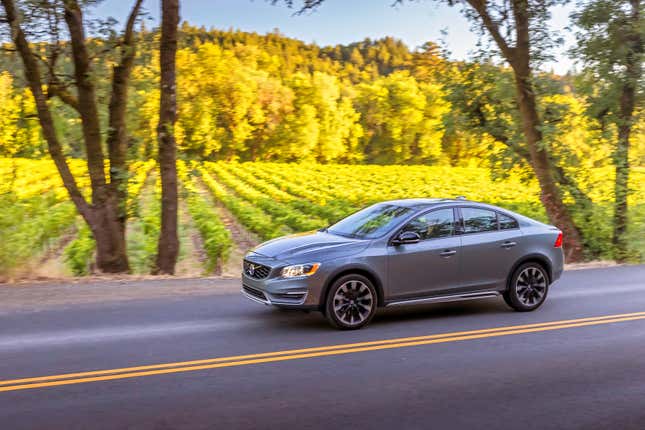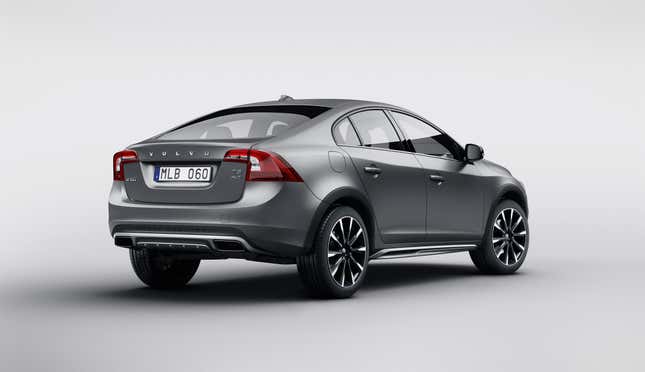The Volvo S60 Cross Country Was a Puzzling Attempt at an SUV-ified Sedan

Sedan sales have been on the decline for years. You know it and I know it. Americans can’t get enough crossovers and SUVs. It’s why there’s a dizzying amount of utility models available from nearly every car manufacturer. But some brands still try to make sedans work, and sometimes they try to broaden the conventional four-door’s appeal by making something nobody asked for. That was the Volvo S60 Cross Country.
Take a sedan and give it the ride height of an SUV. It’s nothing new. AMC did it with its Eagle line in the early 1980s. Subaru did it in the late 1990s with its Legacy Outback sedan. Toyota is trying it out currently with the Crown. It’s something different and new to some people. But Volvo doing it in the 2010s was sort of strange, considering the state of the company and its offerings at the time.
For years, Volvo never actually sold an SUV or crossover, even after those vehicles had become extremely popular in the U.S. The company’s first attempt to please potential 4×4 buyers was the first Cross Country model, the V70 XC, introduced in 1997. It was essentially a raised-up version of the standard V70 wagon, with unpainted black plastic body cladding and unique exterior trim.
1997 Volvo V70 XCImage: Volvo
And it worked — because it was a wagon. Buyers didn’t just want the added ride height and commanding view that SUVs offered, they wanted the cargo space, and the V70 Cross Country had that. The Cross Country lineup expanded in later years to include V60 and V90 Cross Country wagons (and the V40 Cross Country, never sold in the U.S.).
But for some reason, for the 2016 model year, things changed. Volvo decided to introduce a Cross Country sedan.
The S60 Cross Country was based on the second-generation S60 sedan, which still rode on a Ford-designed platform introduced a decade prior. The ride height was raised; black fender extensions were added; all-wheel drive, skid plates front and rear, and hill decent control rounded out the Cross Country makeover. Power came from a 2.5-liter turbocharged inline-5 paired with a six-speed automatic. It made 250 horsepower and 266 lb-ft of torque, and was the sole engine option.

Image: Volvo
These changes made the S60 Cross Country unique, but they also made this sedan into a car of “buts.” The raised ride height was great for easy entry and exit, plus an SUV-like view of the road… but it made handling worse. The dated, on-its-way-out inline-5 was later replaced by a modern 2.0-liter turbo four-cylinder… but only in the last model year of S60 Cross Country production. The 7.9-inch ground clearance sounded impressive… but only in the context of other sedans. As Car and Driver pointed out in their review of the 2016 S60 Cross Country, the Volvo’s ride height was still lower than true crossovers like the Subaru Forester and Jeep Renegade.
And then there’s the practical matter. Buyers might look at the S60 Cross Country and envision adventures in the great outdoors… but the sedan’s trunk only offered 12 cubic feet of space, compared to the V60 Cross Country’s 28 (or 43 with the rear seats folded). The S60 Cross Country’s existence begged the question of why someone wouldn’t just go for the V60 Cross Country — or Volvo’s actual SUVs, the XC90 that debuted in 2003 or the XC60 that arrived in 2010.

Image: Volvo
Pricing wasn’t any better. While the S60 Cross Country was cheaper than the V60 Cross Country, it wasn’t by much. Loaded out, a V60 Cross Country could ring in at just under $50,000. An S60 Cross Country came in at just over $48,000 loaded — and both cost more than the Volvo XC60.
Volvo seemed to know that the S60 Cross Country wasn’t going to be a big seller. Initially, Volvo only planned to bring 500 examples to the U.S. for its first model year in 2016; the company ended up selling 1,887 of them. Sales declined every year through the end of the car’s life. In 2017 just 312 found homes; in 2018, Volvo only sold 203 S60 Cross Country sedans, including just one in December of that year.
Could the S60 Cross Country be a cautionary tale for the Toyota Crown? Maybe. But they’re both examples of automakers trying to make something unique to appeal to more buyers, an effort at mixing the styling of a sedan with the practicality of a crossover. If the fate of the S60 Cross Country tells us anything, it’s that the world might not be ready for such a vehicle.



